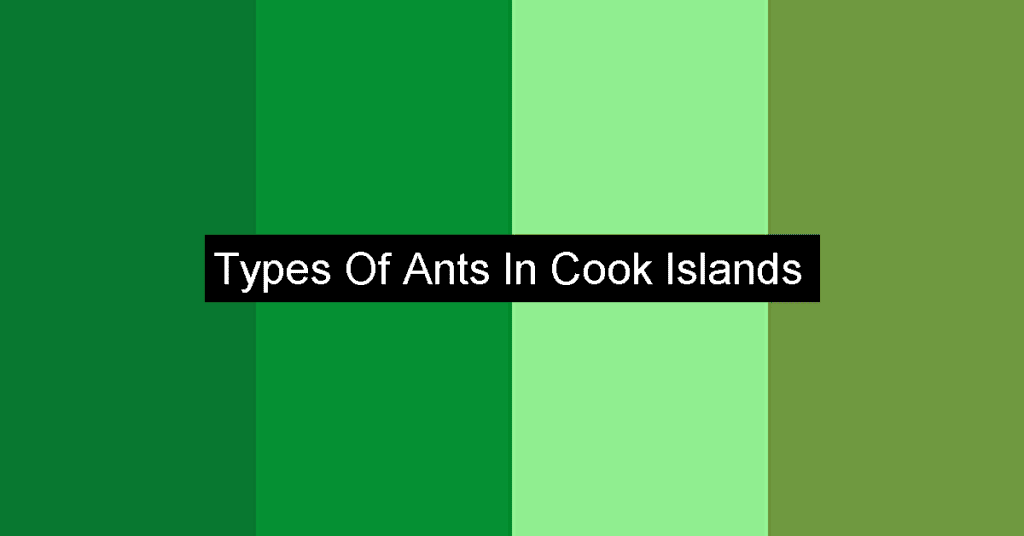Nestled in the heart of the South Pacific Ocean lies the Cook Islands, a stunning archipelago consisting of 15 islands and islets. The region is located northeast of New Zealand and is divided into two distinct groups: the Northern Group and the Southern Group.
The Cook Islands boast a tropical climate with warm temperatures year-round, making it a popular destination for tourists seeking a paradise getaway. The islands are home to a diverse range of flora and fauna, including exotic birds, marine life, and lush vegetation.
The crystal-clear waters surrounding the islands are teeming with colorful fish and coral reefs, making it a popular spot for snorkeling and diving enthusiasts. With its pristine beaches, turquoise waters, and abundant wildlife, the Cook Islands offer a unique and unforgettable experience for nature lovers and adventure seekers alike.
.
Types Of Ants In Cook Islands
The Types Of Ants In Cook Islands are listed here: Trap-Jaw Ants, Acrobat Ants, Harvester Ants, Trailing Pharaoh And Timid Ants, Crazy Ants, Trap-Jaw Ants, Crazy Ants, Big Headed Ants, Emerys Sneaking Ants, Flower Ants, Crazy Ants, Longhorn Crazy Ants, Big Headed Ants, Ghost Ants, Pale-Footed Ants, Singapore Ants.
If you’ve found some other ants in this region, contact us, and we will add them to the list!
1) Trap-Jaw Ants, Anochetus
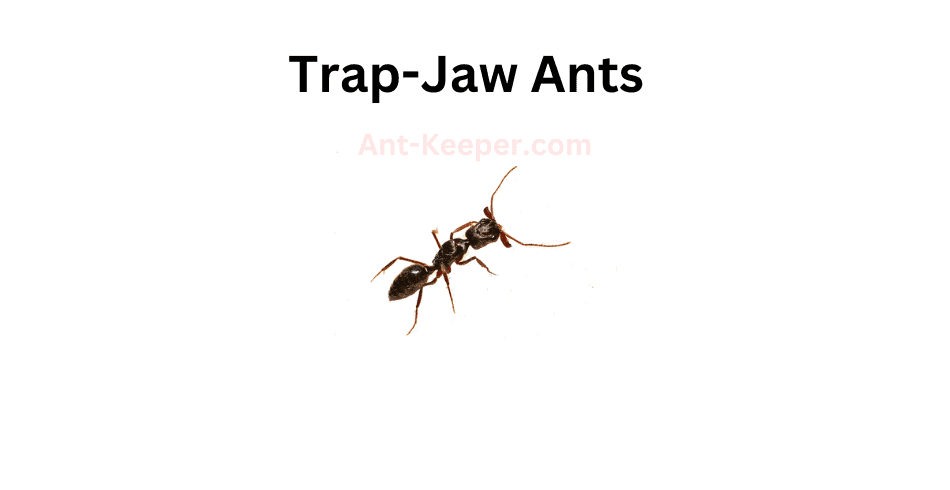
Trap-jaw ants are a species of ants that belong to the genus Odontomachus.
These ants are known for their unique and powerful mandibles, which they use to capture prey and defend their colonies.
The mandibles of trap-jaw ants are capable of closing at incredible speeds, reaching up to 140 miles per hour.
This allows them to snap their jaws shut with incredible force, which can stun or kill their prey.
Trap-jaw ants are found in a variety of habitats, including forests, grasslands, and deserts.
They are typically active during the day and are known to be highly territorial.
These ants are also known for their ability to jump, which they use to escape danger or to capture prey.
Trap-jaw ants are omnivorous, meaning that they eat both plant and animal matter.
They are known to feed on a variety of insects, including other ants, as well as nectar and other sweet substances.
These ants are also known to be scavengers, feeding on dead insects and other organic matter.
The colonies of trap-jaw ants are typically small, with only a few hundred individuals.
However, they are highly organized and have a strict social hierarchy.
The queen is the largest member of the colony and is responsible for laying eggs.
The workers, which are all female, are responsible for foraging, caring for the young, and defending the colony.
Overall, trap-jaw ants are fascinating creatures that have evolved unique adaptations to help them survive in their environments.
Their powerful mandibles and jumping abilities make them formidable predators, while their social organization allows them to work together to protect their colonies and ensure their survival.
2) Acrobat Ants, Crematogaster

Acrobat ants, also known as Crematogaster spp., are a genus of ants that are found in various parts of the world.
These ants are known for their unique ability to contort their bodies and move in acrobatic ways, hence their name.
Acrobat ants are relatively small, with workers measuring between 2-5mm in length.
They are typically brown or black in color, with a slender body and long legs.
These ants are known for their aggressive behavior and will readily defend their nests against intruders.
One of the most interesting features of acrobat ants is their ability to use their mandibles to grip onto surfaces and contort their bodies in unusual ways.
This allows them to move along narrow branches, twigs, and other surfaces that would be difficult for other ants to navigate.
They are also able to use this ability to escape from predators, such as birds and other insects.
Acrobat ants are omnivorous, meaning that they will eat both plant and animal matter.
They are known to feed on insects, nectar, and honeydew, as well as fruits and seeds.
These ants are also known to tend to aphids, protecting them from predators in exchange for the sweet honeydew that the aphids produce.
In terms of their social structure, acrobat ants are typically organized into colonies that are led by a queen.
The queen is responsible for laying eggs, while the workers are responsible for foraging, caring for the young, and defending the nest.
Overall, acrobat ants are fascinating creatures that have adapted unique abilities to survive in their environments.
Their acrobatic abilities and aggressive behavior make them a formidable force in the insect world.
3) Harvester Ants, Messor

Harvester ants are a type of ant that belongs to the genus Pogonomyrmex.
They are known for their impressive ability to collect and store seeds, which they use as their primary source of food.
These ants are typically found in arid and semi-arid regions, where they play an important role in the ecosystem by dispersing seeds and aerating the soil.
Harvester ants are social insects that live in large colonies, which can contain thousands of individuals.
The colony is typically headed by a queen, who is responsible for laying eggs and maintaining the social structure of the colony.
The workers, which are all female, are responsible for foraging, nest maintenance, and caring for the young.
One of the most impressive features of harvester ants is their ability to navigate long distances to find food.
They use a combination of visual cues and chemical signals to locate and retrieve seeds, which they then bring back to the nest.
Once inside the nest, the seeds are stored in underground chambers, where they are protected from predators and other environmental factors.
Harvester ants are also known for their aggressive behavior, particularly when it comes to defending their nest and food sources.
They have powerful mandibles that they use to bite and sting potential threats, including humans.
As a result, it is important to exercise caution when encountering these ants in the wild.
Overall, harvester ants are fascinating creatures that play an important role in their ecosystem.
Their ability to collect and store seeds, navigate long distances, and defend their colony make them a formidable force in the world of insects.
4) Trailing Pharaoh And Timid Ants, Monomorium

The Trailing Pharaoh ant, also known as the Monomorium pharaonis, is a small, reddish-brown ant species that is commonly found in urban areas.
These ants are known for their ability to form large colonies, which can consist of thousands of individuals.
One interesting behavior of the Trailing Pharaoh ant is their tendency to trail behind other ants.
This behavior is thought to be a form of communication, as the trailing ants are able to follow the scent trail left by the leading ants.
This behavior is also used to locate food sources, as the trailing ants are able to follow the trail to the source of the food.
In contrast to the bold behavior of the Trailing Pharaoh ant, the Timid ant, also known as the Temnothorax species, is a much more cautious species.
These ants are small and brown, and are often found in wooded areas.
They are known for their timid behavior, and will often retreat into their nests when threatened.
Despite their timid nature, the Timid ant is still able to form large colonies.
They are also known for their ability to adapt to changing environments, and can be found in a variety of habitats, including forests, meadows, and even urban areas.
Overall, both the Trailing Pharaoh ant and the Timid ant are fascinating species that demonstrate unique behaviors and adaptations.
By studying these ants, scientists can gain a better understanding of the complex social behaviors and ecological roles of ants in their respective environments.
5) Crazy Ants, Nylanderia
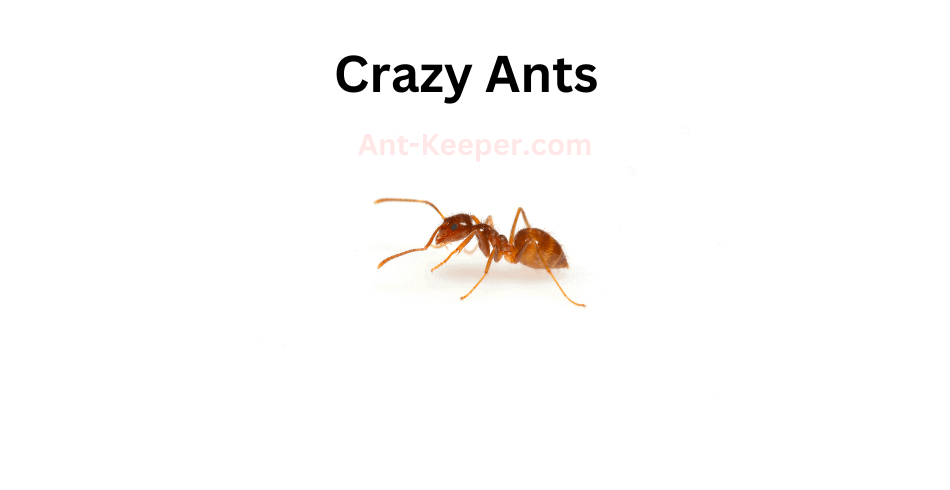
Crazy ants, also known as Nylanderia fulva, are a species of ant that belong to the family Formicidae.
They are small in size, measuring only about 2.2 to 3 mm in length, and are reddish-brown in color.
These ants are known for their erratic and unpredictable behavior, hence the name "crazy ants."
Crazy ants are native to South America, but have since spread to other parts of the world, including North America, Asia, and Australia.
They are highly adaptable and can thrive in a variety of environments, including urban areas, forests, and grasslands.
One of the most notable characteristics of crazy ants is their ability to form large colonies with multiple queens.
This allows them to quickly establish themselves in new areas and outcompete other ant species.
Crazy ants are also known for their aggressive behavior towards other insects and animals, including humans.
In addition to their aggressive behavior, crazy ants are also known for their ability to cause damage to electrical equipment.
They are attracted to electrical currents and can easily short-circuit electronics, causing damage and potentially starting fires.
Despite their small size, crazy ants are a formidable species that can have a significant impact on their environment.
As they continue to spread to new areas, it is important to monitor their behavior and take steps to control their populations in order to minimize their impact on ecosystems and human infrastructure.
6) Trap-Jaw Ants, Odontomachus

Trap-jaw ants are a species of ants that belong to the genus Odontomachus.
These ants are known for their unique and powerful mandibles, which they use to capture prey and defend their colonies.
The mandibles of trap-jaw ants are capable of closing at incredible speeds, reaching up to 140 miles per hour.
This allows them to snap their jaws shut with incredible force, which can stun or kill their prey.
Trap-jaw ants are found in a variety of habitats, including forests, grasslands, and deserts.
They are typically active during the day and are known to be highly territorial.
These ants are also known for their ability to jump, which they use to escape danger or to capture prey.
Trap-jaw ants are omnivorous, meaning that they eat both plant and animal matter.
They are known to feed on a variety of insects, including other ants, as well as nectar and other sweet substances.
These ants are also known to be scavengers, feeding on dead insects and other organic matter.
The colonies of trap-jaw ants are typically small, with only a few hundred individuals.
However, they are highly organized and have a strict social hierarchy.
The queen is the largest member of the colony and is responsible for laying eggs.
The workers, which are all female, are responsible for foraging, caring for the young, and defending the colony.
Overall, trap-jaw ants are fascinating creatures that have evolved unique adaptations to help them survive in their environments.
Their powerful mandibles and jumping abilities make them formidable predators, while their social organization allows them to work together to protect their colonies and ensure their survival.
7) Crazy Ants, Paratrechina

Crazy ants, also known as Nylanderia fulva, are a species of ant that belong to the family Formicidae.
They are small in size, measuring only about 2.2 to 3 mm in length, and are reddish-brown in color.
These ants are known for their erratic and unpredictable behavior, hence the name "crazy ants."
Crazy ants are native to South America, but have since spread to other parts of the world, including North America, Asia, and Australia.
They are highly adaptable and can thrive in a variety of environments, including urban areas, forests, and grasslands.
One of the most notable characteristics of crazy ants is their ability to form large colonies with multiple queens.
This allows them to quickly establish themselves in new areas and outcompete other ant species.
Crazy ants are also known for their aggressive behavior towards other insects and animals, including humans.
In addition to their aggressive behavior, crazy ants are also known for their ability to cause damage to electrical equipment.
They are attracted to electrical currents and can easily short-circuit electronics, causing damage and potentially starting fires.
Despite their small size, crazy ants are a formidable species that can have a significant impact on their environment.
As they continue to spread to new areas, it is important to monitor their behavior and take steps to control their populations in order to minimize their impact on ecosystems and human infrastructure.
8) Big Headed Ants, Pheidole
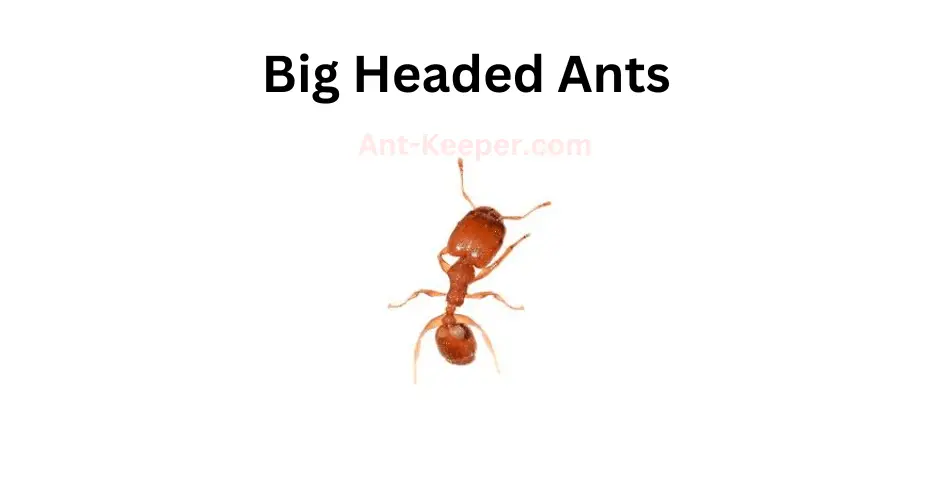
Big Headed Ants, also known as Pheidole megacephala, are a species of ant that belong to the family Formicidae.
These ants are known for their distinctive large heads, which are used for defense and communication within their colonies.
Big Headed Ants are typically found in tropical and subtropical regions, where they build their nests in soil, leaf litter, and other organic matter.
They are omnivorous, feeding on a variety of insects, seeds, and other small organisms.
One of the most interesting aspects of Big Headed Ants is their social behavior.
They live in large colonies, with a queen ant at the center of the hierarchy.
The queen is responsible for laying eggs, while the other ants in the colony perform various tasks such as foraging for food, caring for the young, and defending the colony from predators.
Big Headed Ants are also known for their ability to displace other ant species in their habitats.
They are aggressive and have been known to attack and kill other ants, as well as compete with them for resources.
Despite their aggressive behavior, Big Headed Ants are not considered a major pest species.
However, their ability to displace other ant species and their potential impact on native ecosystems make them an important species to study and monitor.
9) Emerys Sneaking Ants, Cardiocondyla Emeryi
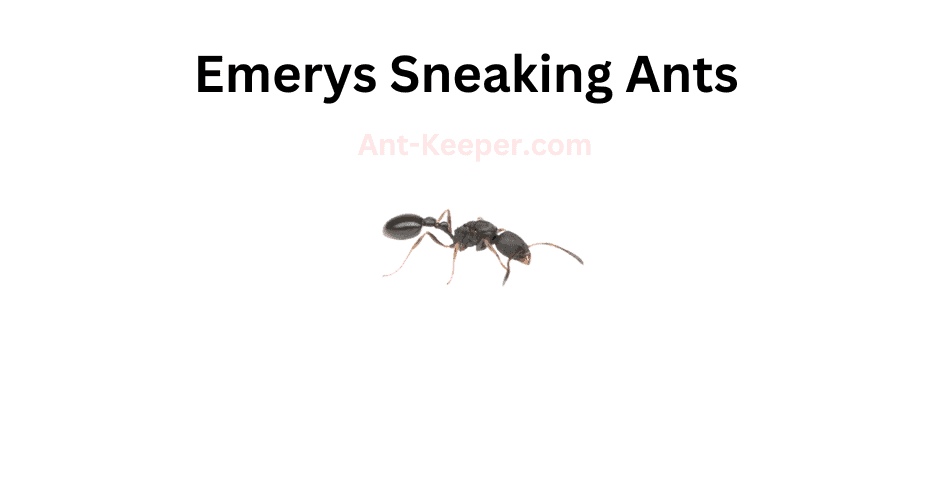
Emery's Sneaking Ants, also known as Pheidole emeryi, are a species of ant that belong to the family Formicidae.
These ants are known for their ability to sneak into other ant colonies and steal their resources without being detected.
Emery's Sneaking Ants are small in size, measuring only 2-3 mm in length.
They have a dark brown or black coloration and a distinctively large head in proportion to their body.
Their mandibles are also relatively large, which allows them to carry larger food items back to their own colony.
These ants are primarily found in forested areas and are known to be opportunistic feeders.
They will consume a variety of food sources, including other insects, nectar, and honeydew.
However, they are also known to steal food from other ant colonies, which is where they get their name.
Emery's Sneaking Ants have a unique strategy for infiltrating other ant colonies.
They will send out scouts to locate a nearby colony and then send in a small group of worker ants to steal food.
These worker ants will use their small size and agility to sneak past the guards of the other colony and steal food without being detected.
Despite their sneaky behavior, Emery's Sneaking Ants are not considered harmful to other ant colonies.
They do not engage in aggressive behavior and are not known to cause any significant damage to other ant colonies.
However, they are still an interesting species to study and observe in their natural habitat.
10) Flower Ants, Monomorium Floricola
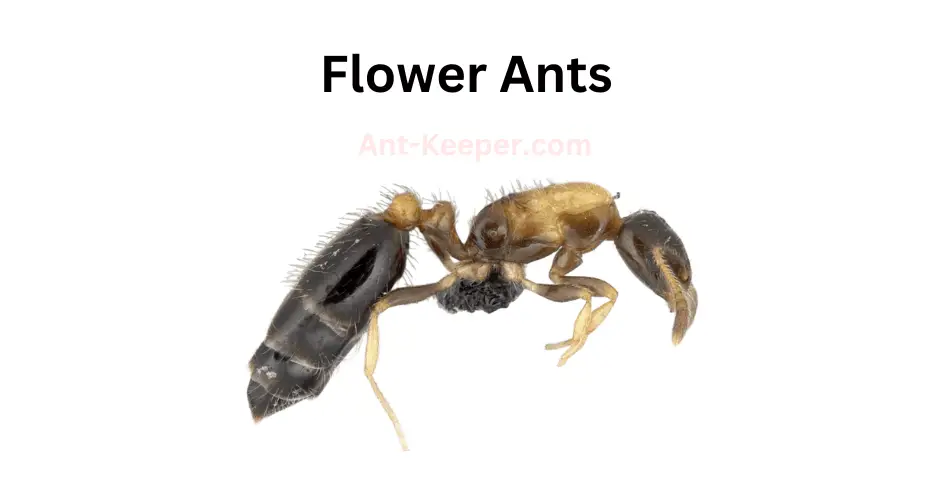
The Flower Ant, also known as the Camponotus consobrinus, is a species of ant that belongs to the Camponotus genus.
These ants are commonly found in various habitats, including forests, grasslands, and gardens.
They are known for their unique behavior of collecting nectar and pollen from flowers, hence their name.
The Flower Ants are relatively large, with workers measuring up to 12mm in length.
They have a black or dark brown body with reddish-brown legs and antennae.
The queen ants are even larger, measuring up to 18mm in length.
These ants are known for their strong mandibles, which they use to cut through plant material and defend their colony.
The Flower Ants are social insects that live in colonies consisting of a queen, workers, and males.
The queen is responsible for laying eggs, while the workers take care of the young and forage for food.
The males are responsible for mating with the queen.
One of the unique characteristics of the Flower Ants is their relationship with plants.
They are known to collect nectar and pollen from flowers, which they use as a source of food.
In return, they help pollinate the flowers, which is essential for the plants' reproduction.
The Flower Ants are also known for their aggressive behavior towards other ant species.
They will defend their territory and resources fiercely, often engaging in battles with other ant colonies.
In conclusion, the Flower Ants are a fascinating species of ant that have a unique relationship with plants.
They play an important role in pollination and are essential for the ecosystem.
Their aggressive behavior towards other ant species also highlights their importance in maintaining the balance of the ecosystem.
11) Crazy Ants, Nylanderia Bourbonica

Crazy ants, also known as Nylanderia fulva, are a species of ant that belong to the family Formicidae.
They are small in size, measuring only about 2.2 to 3 mm in length, and are reddish-brown in color.
These ants are known for their erratic and unpredictable behavior, hence the name "crazy ants."
Crazy ants are native to South America, but have since spread to other parts of the world, including North America, Asia, and Australia.
They are highly adaptable and can thrive in a variety of environments, including urban areas, forests, and grasslands.
One of the most notable characteristics of crazy ants is their ability to form large colonies with multiple queens.
This allows them to quickly establish themselves in new areas and outcompete other ant species.
Crazy ants are also known for their aggressive behavior towards other insects and animals, including humans.
In addition to their aggressive behavior, crazy ants are also known for their ability to cause damage to electrical equipment.
They are attracted to electrical currents and can easily short-circuit electronics, causing damage and potentially starting fires.
Despite their small size, crazy ants are a formidable species that can have a significant impact on their environment.
As they continue to spread to new areas, it is important to monitor their behavior and take steps to control their populations in order to minimize their impact on ecosystems and human infrastructure.
12) Longhorn Crazy Ants, Paratrechina Longicornis
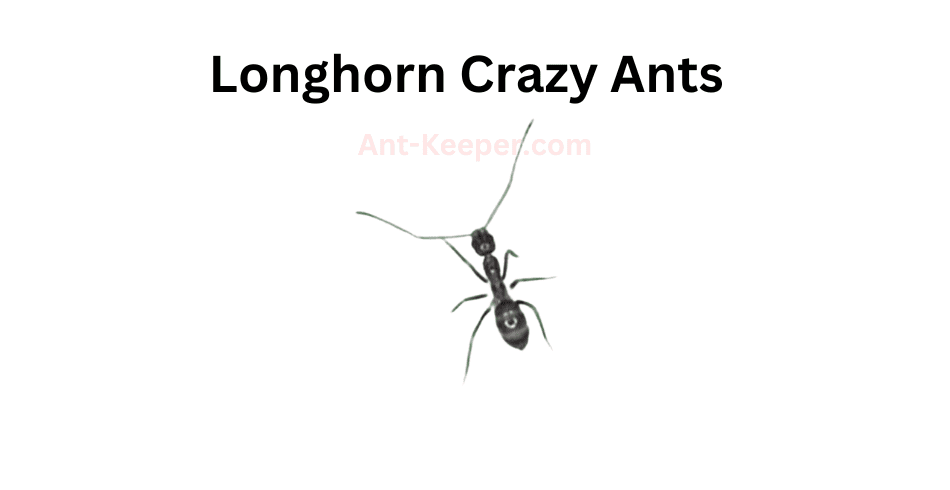
The Longhorn Crazy Ant (Paratrechina longicornis) is a small, dark brown ant species that is known for its erratic and unpredictable behavior.
These ants are typically found in warm, humid environments and are often found in urban areas, where they can be a nuisance to homeowners and businesses.
One of the most distinctive features of the Longhorn Crazy Ant is its long, slender antennae, which can be up to twice the length of its body.
These antennae are used to detect chemical signals from other ants and to navigate through their environment.
Longhorn Crazy Ants are omnivorous and will feed on a wide variety of foods, including insects, fruits, and sweet liquids.
They are also known to be scavengers, and will often invade other ant colonies to steal food and resources.
One of the most interesting aspects of the Longhorn Crazy Ant is its behavior.
These ants are known for their erratic movements and unpredictable behavior, which can make them difficult to control.
They are also known for their ability to form large, sprawling colonies that can quickly take over an area.
Despite their small size, Longhorn Crazy Ants can be a significant pest problem, particularly in urban areas.
They can invade homes and businesses, contaminate food, and cause damage to electrical equipment.
As a result, it is important to take steps to control these ants and prevent infestations from occurring.
13) Big Headed Ants, Pheidole Megacephala

Big Headed Ants, also known as Pheidole megacephala, are a species of ant that belong to the family Formicidae.
These ants are known for their distinctive large heads, which are used for defense and communication within their colonies.
Big Headed Ants are typically found in tropical and subtropical regions, where they build their nests in soil, leaf litter, and other organic matter.
They are omnivorous, feeding on a variety of insects, seeds, and other small organisms.
One of the most interesting aspects of Big Headed Ants is their social behavior.
They live in large colonies, with a queen ant at the center of the hierarchy.
The queen is responsible for laying eggs, while the other ants in the colony perform various tasks such as foraging for food, caring for the young, and defending the colony from predators.
Big Headed Ants are also known for their ability to displace other ant species in their habitats.
They are aggressive and have been known to attack and kill other ants, as well as compete with them for resources.
Despite their aggressive behavior, Big Headed Ants are not considered a major pest species.
However, their ability to displace other ant species and their potential impact on native ecosystems make them an important species to study and monitor.
14) Ghost Ants, Tapinoma Melanocephalum
Ghost ants, also known as tapinoma melanocephalum, are a species of small, pale-colored ants that are commonly found in tropical and subtropical regions around the world.
These ants are known for their elusive behavior and their ability to quickly disappear when disturbed, earning them their ghostly name.
Ghost ants are typically only about 1.5 to 2 millimeters in length, making them one of the smallest ant species.
They have a pale yellow or white body with a dark head and thorax, which gives them a distinctive appearance.
Ghost ants are also known for their ability to quickly move and navigate through narrow spaces, making them difficult to control in indoor environments.
Ghost ants are omnivorous and will feed on a variety of food sources, including sweets, meats, and fats.
They are also known to feed on other insects and their larvae.
Ghost ants are social insects and live in large colonies, with a single queen ant responsible for laying eggs and producing new workers.
One of the biggest challenges with controlling ghost ants is their ability to quickly adapt to changes in their environment.
They are known to quickly relocate their nests when disturbed, making it difficult to locate and eliminate the colony.
Additionally, ghost ants are resistant to many common insecticides, making it important to use targeted control methods.
Overall, ghost ants are a fascinating and elusive species of ant that can be difficult to control in indoor environments.
Understanding their behavior and biology is key to effectively managing infestations and preventing future problems.
15) Pale-Footed Ants, Technomyrmex Vitiensis

Pale-Footed Ants, also known as Pheidole pallidula, are a species of ant belonging to the family Formicidae.
These ants are typically small in size, measuring around 2-3mm in length, and are characterized by their pale yellowish-brown coloration and distinctive pale-colored feet.
Pale-Footed Ants are known for their highly organized social structure, which is divided into different castes including workers, soldiers, and reproductive individuals.
Workers are responsible for foraging for food, caring for the young, and maintaining the nest, while soldiers are tasked with defending the colony from predators and other threats.
One of the most interesting aspects of Pale-Footed Ant behavior is their ability to engage in "tandem running," a process in which two ants run together, with the follower using its antennae to track the movements of the leader.
This behavior is thought to help the ants navigate their environment more efficiently and locate food sources more quickly.
Pale-Footed Ants are also known for their unique feeding habits, which include a preference for sweet liquids such as nectar and honeydew.
They are also known to engage in trophallaxis, a process in which food is shared between members of the colony through mouth-to-mouth transfer.
Overall, Pale-Footed Ants are a fascinating species with a complex social structure and unique behaviors.
Their small size and inconspicuous appearance make them easy to overlook, but their importance in maintaining ecological balance and contributing to the overall health of their ecosystem should not be underestimated.
16) Singapore Ants, Trichomyrmex Destructor
The Singapore ant, also known as the Asian needle ant, is a species of ant that belongs to the Formicidae family.
These ants are known for their aggressive behavior and are considered to be a nuisance pest in many areas.
They are typically found in urban and suburban environments, where they can be seen foraging for food and building their nests.
The Singapore ant is a small ant, measuring only a few millimeters in length.
They are typically black or dark brown in color, with a slender body and long legs.
These ants are known for their sharp stingers, which they use to defend themselves and their colony.
The Singapore ant is a social insect, living in large colonies that can contain thousands of individuals.
They are organized into a caste system, with workers, soldiers, and a queen.
The workers are responsible for foraging for food, caring for the young, and maintaining the nest.
The soldiers are larger and more aggressive, and are responsible for defending the colony from predators.
These ants are omnivorous, feeding on a variety of foods including insects, fruits, and sweet substances.
They are known for their ability to adapt to different environments, and can be found in a variety of habitats including forests, grasslands, and urban areas.
Despite their small size, the Singapore ant can be a significant pest in urban areas.
They are known for their aggressive behavior and can sting humans and pets if provoked.
They can also damage crops and invade homes in search of food.
Overall, the Singapore ant is a fascinating species of ant that is well adapted to urban environments.
While they can be a nuisance pest, they play an important role in the ecosystem and are an important part of the food chain.
Check Out Some Of Our Other Ants By Location Posts
| Types Of Ants In Maranhao, Brazil | Maranhão is a state located in the northeastern region of Brazil, known for its diverse and unique environment. The state is home to a variety ... |
| Types Of Ants In Equatorial Guinea | Nestled on the west coast of Central Africa lies Equatorial Guinea, a small country known for its lush rainforests, diverse wildlife, and tropical climate. The ... |
| Types Of Ants In Baja California Sur, Mexico | Baja California Sur is a region located in the southern part of the Baja California Peninsula in Mexico. This region is known for its unique ... |
| Types Of Ants In Montenegro | Montenegro, a small country located in Southeast Europe, is a land of diverse landscapes and rich biodiversity. The country is bordered by Croatia, Bosnia and ... |
| Types Of Ants In Santiago Del Estero, Argentina | Santiago del Estero, located in the north-central region of Argentina, is a land of diverse landscapes and unique wildlife. The region is known for its ... |
